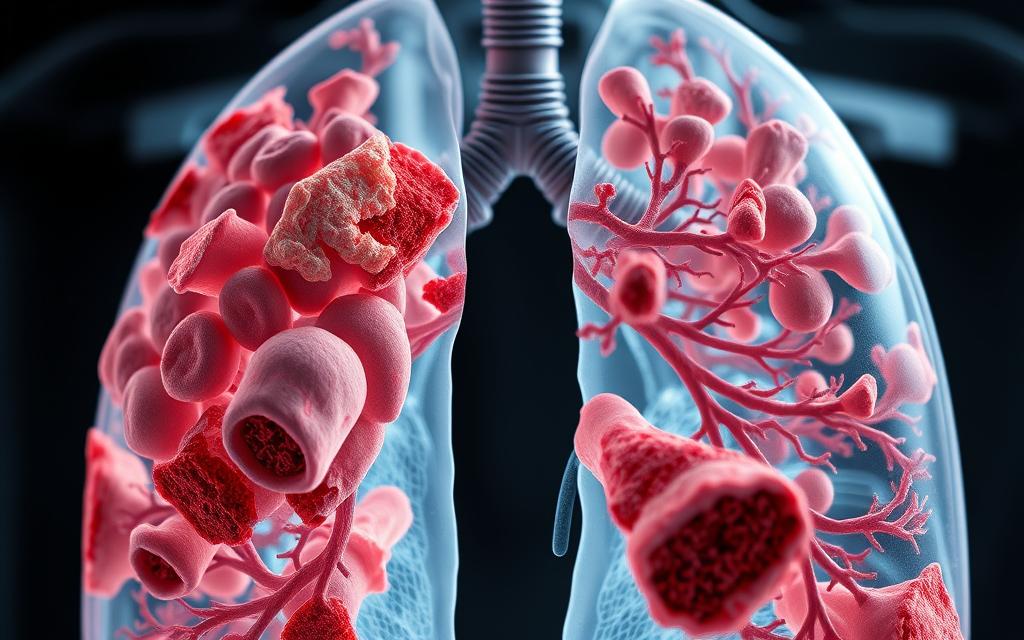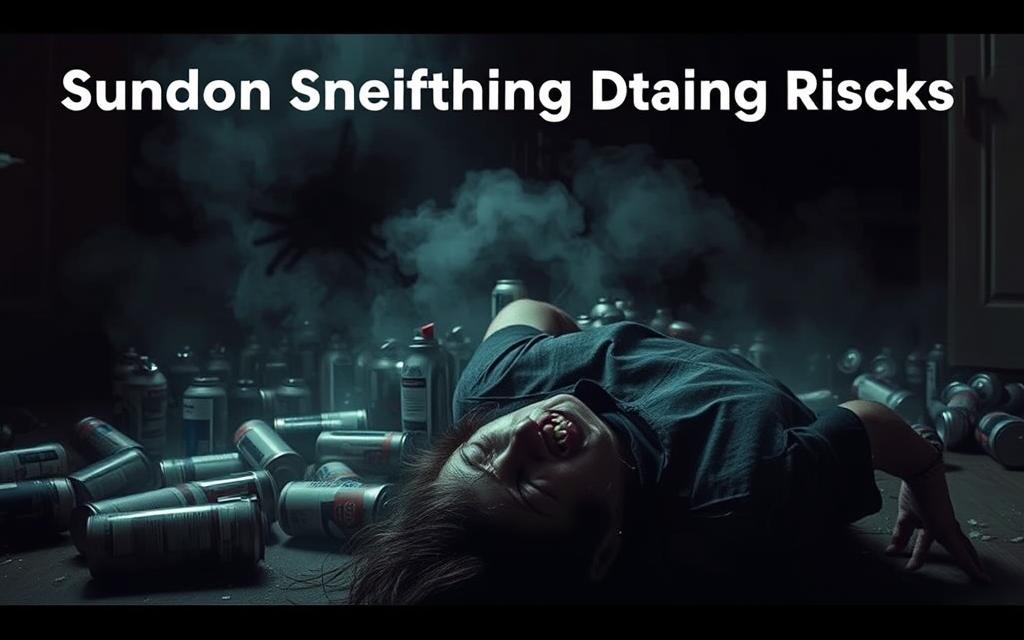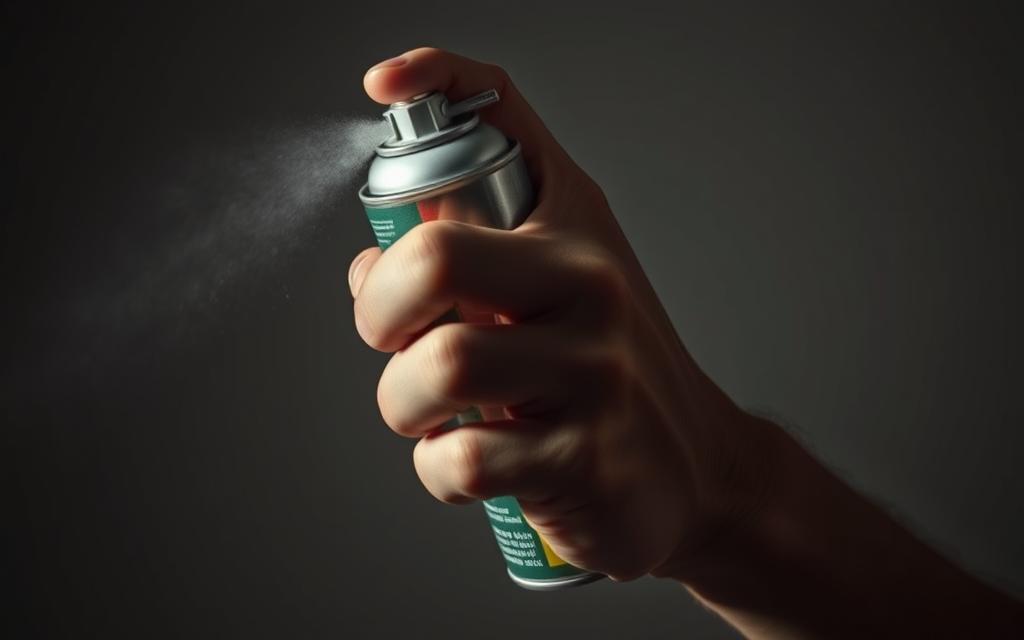Table of Contents
Inhaling compressed air or duster chemicals poses serious health threats. These products contain toxic gases like fluorinated hydrocarbons and butane, which can cause severe damage to the lungs and brain.
Accidental exposure may occur during cleaning, but intentional misuse for a euphoric high is far more dangerous. Even brief contact can lead to frostbite, organ failure, or sudden sniffing death syndrome.
Immediate effects include dizziness, nausea, and irregular heartbeat. Long-term exposure may result in irreversible harm. If gas enters the mouth or respiratory system, seek emergency care immediately—even minor symptoms can escalate rapidly.
Understanding Computer Duster and Its Risks
Many don’t realize the dangers lurking in common electronics cleaning products. Marketed as air dusters or canned air, these cans contain compressed gas designed to dislodge dust—not for human inhalation.
What Is Computer Duster?
These products typically use chemicals like difluoroethane or butane as propellants. Labels warn against misuse, yet their accessibility makes them a target for abuse. Even brief exposure can disrupt oxygen flow in the body.
Why Is It Dangerous?
The chemicals in air dusters act as asphyxiants, replacing oxygen in the bloodstream. This can trigger heart failure or frostbite from rapid gas expansion. SAMHSA reports 1% of adolescents misuse inhalants, often underestimating the risks.
“Sudden sniffing death syndrome can occur on first use, with no warning signs.”
People with asthma or heart conditions face heightened danger. Always use these products in ventilated areas and store them securely.
What Happens When You Get Computer Duster in Your Mouth
Exposure to aerosol cleaning products can trigger alarming physical responses. The gas propellants irritate oral tissues upon contact, causing a sharp burning sensation. Coughing fits and throat swelling often follow as the body attempts to expel the chemicals.

Immediate Physical Reactions
Within seconds, the effects escalate. Frostbite-like injuries may occur in the mouth or nasal passages due to rapid gas expansion. Other symptoms include:
- Dizziness or confusion from oxygen deprivation
- Nausea and vomiting as the body reacts to toxins
- Slurred speech in severe cases
Accidental vs. Intentional Exposure
Brief overspray incidents typically resolve after rinsing with water. However, deliberate inhalation—often called “huffing”—floods the lungs with concentrated toxins. This drug misuse can cause hallucinations or loss of consciousness.
“Even single exposures may lead to lasting damage. Always consult healthcare providers after accidental ingestion.”
Repeated exposure worsens harm over time, sometimes causing issues days later. Medical evaluation ensures no delayed complications arise.
Short-Term Side Effects of Inhaling Air Duster
The immediate consequences of aerosol misuse strike faster than most expect. Chemicals like difluoroethane attack the body within seconds, triggering life-threatening side effects. Victims often experience dual crises—respiratory collapse and neurological chaos.
Respiratory and Neurological Symptoms
Lungs bear the brunt of chemical assault. Inhaled toxins cause inflammation, leading to wheezing, coughing, and breathlessness. Severe cases may progress to pulmonary edema, where fluid floods airways.
Simultaneously, the brain suffers oxygen starvation. Depressants in air duster chemicals slow neural activity, causing confusion, slurred speech, or seizures. Hallucinations and loss of coordination signal advanced nervous system damage.
Frostbite and Skin Damage
Liquefied gases exit cans at -50°F, freezing tissues on contact. Common injuries include:
- White or grayish patches on lips or nostrils
- Blisters resembling burns from frostbite
- Necrosis in severe cases, requiring surgical intervention
“Combining inhalants with other drug abuse multiplies mortality risks by 14x.”
Blue lips or nails indicate critical oxygen loss. Without prompt treatment, victims may faint or slip into comas. Even brief exposure demands medical evaluation.
Long-Term Health Consequences
The hidden dangers of prolonged inhalant misuse often surface years later. What begins as temporary euphoria can escalate into life-altering conditions, affecting every major organ system. Unlike short-term effects, these consequences may develop silently, only becoming apparent after irreversible damage occurs.

Organ Damage: A Silent Crisis
The brain suffers the most visible decline. Chronic exposure to aerosol toxins kills nerve cells, leading to memory loss and reduced cognitive function. Studies link repeated misuse to conditions resembling early-onset dementia.
Heart tissue becomes vulnerable to arrhythmias, even in young users. These irregular beats can trigger cardiac arrest without warning—a phenomenon called sudden sniffing death syndrome.
Lungs develop scar tissue (pulmonary fibrosis) from chemical burns. This reduces oxygen absorption, causing chronic fatigue and respiratory failure. Below is a breakdown of organ-specific risks:
| Organ | Damage Type | Outcome |
|---|---|---|
| Brain | Nerve cell death | Memory loss, tremors |
| Heart | Arrhythmias | Sudden cardiac death |
| Lungs | Fibrosis | Oxygen deprivation |
Addiction and Withdrawal: A Vicious Cycle
Inhalant addiction creeps in unnoticed. Users build tolerance, needing larger doses for the same high. Cravings intensify, often overshadowing concerns about health.
Withdrawal symptoms mimic severe flu: nausea, insomnia, and violent mood swings. Medical detox becomes essential to manage these reactions safely. Without intervention, relapse rates exceed 60%.
“Prolonged abuse rewires the brain’s reward system, making recovery a marathon—not a sprint.”
Early intervention improves outcomes. Behavioral therapies and support groups address the root causes of substance use, offering pathways to recovery.
Air Duster Abuse: Signs and Patterns
Misusing household products as inhalants remains a hidden epidemic. While marketed for cleaning, aerosol propellants are often repurposed to get high, leading to severe abuse cycles. Recognizing the signs early can prevent irreversible harm.
How Inhalants Are Misused
Individuals typically use three methods to inhale toxins:
- Bagging: Spraying drug chemicals into bags and breathing the fumes.
- Huffing: Soaking rags or clothing and pressing them to the face.
- Direct inhalation from cans, risking frostbite and lung damage.
Slang and Behavioral Red Flags
Secretive language hides abuse. Common slang includes:
| Term | Meaning |
|---|---|
| Dusting | Inhaling air duster fumes |
| Sunshine can | Code for aerosol cans |
| Can of sunshine | Alternate name for duster |
Teens are especially vulnerable due to easy access. Warning signs include:
- Hidden empty cans or chemical odors in bedrooms.
- Sudden withdrawal from friends or hobbies.
- Unexplained rashes around the nose or mouth.
“One-time use can disrupt heart rhythms, proving fatal within minutes.”
Chronic users may show weight loss or nosebleeds. Immediate intervention is critical—even sporadic misuse escalates quickly.
Sudden Sniffing Death: A Serious Risk
Among the gravest dangers of inhalant misuse lies an unpredictable killer—sudden sniffing death. This phenomenon strikes without warning, often claiming lives during first-time use. Unlike other drug-related fatalities, it requires no buildup of tolerance or prolonged abuse.

Causes and Prevention
Chemical propellants in aerosol products disrupt the heart‘s electrical signals. Hydrocarbons sensitize cardiac tissue to adrenaline, triggering lethal arrhythmias. Even a single breath can push the heart into fatal irregular beats.
Prevention starts with awareness. Key strategies include:
- Storing aerosol products securely, away from adolescents
- Recognizing early signs like chest pain or palpitations
- Immediately calling 911 if someone collapses after inhalant exposure
Case Studies and Statistics
Data paints a grim picture. SAMHSA reports inhalants cause 22% of substance-related deaths among teens. Over 1,200 annual fatalities occur in the U.S., many from sudden sniffing death.
One tragic case involved a 16-year-old who suffered cardiac arrest after huffing air duster. Despite immediate CPR, the loss of oxygen to his brain proved irreversible.
“No amount of inhalant use is safe—the heart may stop beating without any prior symptoms.”
These incidents underscore why education matters. Schools and parents must address inhalant risks with the same urgency as other drug threats.
Treatment for Air Duster Inhalation or Addiction
Quick action saves lives when dealing with aerosol inhalation emergencies. Proper treatment protocols address both immediate dangers and long-term recovery needs. Understanding these options empowers individuals to respond effectively during critical moments.

Emergency First Aid Steps
Immediate response reduces harm from chemical exposure. Follow these steps if someone inhales aerosol products:
- Move the person to fresh air immediately
- Remove contaminated clothing to prevent further exposure
- Flush affected skin or eyes with lukewarm water for 15 minutes
- Call Poison Control (1-800-222-1222) for expert guidance
Watch for warning symptoms like difficulty breathing or seizures. Never induce vomiting—this may worsen lung damage. Keep the person calm until healthcare arrives.
Medical and Therapeutic Interventions
Hospital teams use specialized approaches for inhalant cases. Emergency treatments often include:
- Oxygen therapy to restore proper blood saturation
- Bronchodilators for respiratory distress
- IV fluids to combat dehydration from vomiting
For addiction cases, inpatient rehab programs show the best results. Cognitive behavioral therapy helps rewire the brain‘s response to cravings. Relapse prevention training builds coping skills for lasting recovery.
“Withdrawal management requires medical supervision—symptoms can include dangerous heart rhythms.”
The SAMHSA helpline (1-800-662-HELP) provides 24/7 support and information. Many patients benefit from dual diagnosis programs that address co-occurring mental health conditions alongside drug abuse issues.
Long-term care may involve support groups and regular check-ups. Recovery transforms life trajectories, but requires ongoing commitment. Early intervention dramatically improves outcomes.
How to Help Someone Struggling with Inhalant Abuse
Supporting individuals battling inhalant misuse requires both knowledge and compassion. Early recognition and non-judgmental dialogue can steer them toward recovery. Below are actionable steps to intervene effectively.
Recognizing the Signs
Behavioral and physical changes often signal inhalant abuse. Key red flags include:
- Empty aerosol cans hidden in personal spaces
- Chemical burns around the nose or mouth
- Sudden declines in work or school performance
Neglected hygiene and secretive behavior are also common. SAMHSA notes these patterns frequently precede deeper substance use issues.
Approaching the Conversation
Initiate talks with empathy, not accusation. Use phrases like:
“I’ve noticed changes that worry me. Let’s talk about how you’re doing.”
Avoid blame—frame concerns around safety. Share treatment options like detox centers or therapy. Below are proven interventions:
| Option | Description | Best For |
|---|---|---|
| Inpatient Rehab | 24/7 medical supervision | Severe addiction |
| Outpatient Programs | Flexible therapy sessions | Early-stage misuse |
| Support Groups | Peer-led recovery meetings | Ongoing maintenance |
Encourage involving healthcare professionals. Specialists can address withdrawal risks and co-occurring mental health conditions. Recovery reshapes life trajectories—but only with sustained support.
Conclusion
Aerosol misuse carries devastating consequences that demand urgent attention. Irreversible damage to the brain, heart, and lungs can occur with even brief exposure.
Sudden sniffing death remains a lethal risk, striking without warning. Addiction to air duster chemicals escalates quickly, requiring professional treatment.
If exposure occurs, contact Poison Control (1-800-222-1222) or SAMHSA immediately. Recovery is possible with medical support and therapy—but delays increase risks.
Never underestimate the lethality of inhalants. Education saves lives.
FAQ
What are the immediate effects of inhaling air duster?
Inhaling canned air can cause dizziness, nausea, hallucinations, and even loss of consciousness. The chemicals displace oxygen, leading to respiratory distress and potential brain damage.
Can computer duster cause sudden death?
Yes, sudden sniffing death syndrome (SSDS) can occur from just one use. The chemicals disrupt heart rhythms, leading to cardiac arrest without warning.
How does air duster abuse affect the brain?
Prolonged exposure damages nerve cells, impairing memory, coordination, and cognitive function. Chronic use may lead to permanent brain damage.
What should I do if someone overdoses on inhalants?
Call 911 immediately. Move the person to fresh air, check for breathing, and perform CPR if necessary. Do not leave them unattended.
Are there withdrawal symptoms from inhalant addiction?
Yes, withdrawal may include tremors, anxiety, insomnia, and seizures. Medical supervision is crucial due to severe health risks.
Why do teens misuse canned air products?
Accessibility and rapid euphoria make inhalants appealing. Peer pressure and misinformation about risks contribute to abuse among adolescents.
What long-term damage does air duster cause?
Chronic use harms the lungs, heart, liver, and kidneys. It may also lead to hearing loss, muscle deterioration, and irreversible neurological disorders.
How can I recognize inhalant abuse in a loved one?
Look for changes like chemical odors, paint stains on clothing, slurred speech, or empty aerosol cans hidden in personal spaces.
Is frostbite possible from air duster exposure?
Yes, the propellant’s extreme cold can freeze skin on contact, causing frostbite injuries to the mouth, nose, or hands.
What treatments exist for inhalant addiction?
Treatment includes medical detox, behavioral therapy, and support groups. A comprehensive rehab program addresses both physical and psychological dependence.









